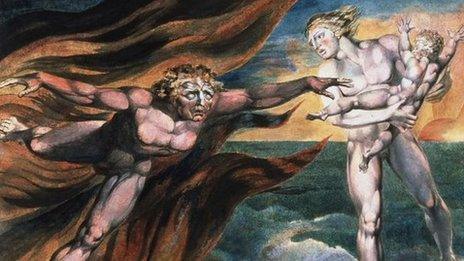Northern Rock: Good bank and bad
- Published
- comments

The government took the decision to separate Northern Rock's good and bad parts
Northern Rock, at the time the UK's fifth-largest lender, was nationalised in February 2008.
In December 2009, the government decided to split the bank into its "good" and "bad" bits - Northern Rock and Northern Rock Asset Management (NRAM).
Both were in public ownership - until the good part, Northern Rock, was sold to Virgin Money for £747m on 17 November 2011.
Why was this done and can we determine the final cost to the taxpayer?
THE GOOD BANK
The nationalised bank was split into two on 1 January 2010.
What remained of the High Street brand and premises of Northern Rock held all savings accounts - about £19bn worth - and also £10bn of the best of the existing mortgages at the time.
The new Northern Rock also carried out new lending, operating as a normal bank in the marketplace without the bad mortgages weighing it down.
It also doesn't have to deal with the burden of the Bank of England's £27bn bailout loan from 2007.
That was the theory, at least. Returning the best parts of Northern Rock to profitability has not been easy.
The company reported a loss of £68.5m for the first six months of 2011, down from a loss of £142.6m in the same period a year earlier.
The bank that Virgin Money takes over currently employs 2,500 people, down from 5,500 when it was nationalised, and has about 70 branches.
Northern Rock expects to become profitable again during the second half of 2012.
Assessing the cost to the taxpayer is complicated by the split.
THE BAD BANK
Bad banks took hold in the US in the 1930s in the years leading up to the Great Depression, as the government and states sought to limit the damage caused by bank failures.
More recently, Sweden had some success in restucturing its entire banking sector in the 1990s by using the same strategy. The Irish also use the model for their bad bank debts.
Firstly, NRAM has disputed the characterisation of itself as a bad bank.
"Ninety percent of the mortgages held by Northern Rock (Asset Management) are fully performing and are not in arrears, and this company would not, therefore, be accurately described as a 'bad' bank," it has said.
NRAM took over the majority of the old nationalised Northern Rock's mortgage book, which amounted to about £50bn.
The objective is to wind down the bad bank and so NRAM is closed to new lending.
However, it continues to provide services to some 540,000 existing borrowers, which breaks down to 365,000 mortgage customers and 175,000 unsecured loan customers.
NRAM was merged with the bad debts of Bradford and Bingley in March 2010, while the building society's better half went to Santander.
Unlike its good bank counterpart, NRAM is in the black - at least on paper.
The bad assets made a pre-tax profit of £291.5m for the first six months of 2011, compared with a £349.7m profit in the previous year.
The old Northern Rock, after its bailout, owed the government £26.9bn at the end of 2007.
In July, NRAM said it now owes £20.7bn of that state loan.
(This does not include another £2.5bn government loan of additional working capital in 2010 to "help with the orderly wind-down of the company".)
However, it is impossible to know just yet how much the NRAM will pay back; that depends on whether customers are able to keep up on their payments.
Currently, 87% of customers at NRAM are up to date on payments.
- Published17 November 2011
- Published17 November 2011
- Published17 November 2011